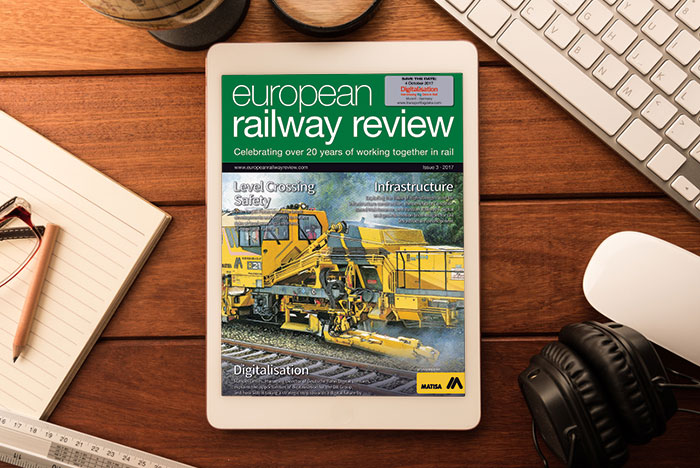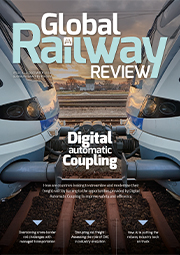Issue #3 2017 – Digital version
Posted: 11 May 2017 | Global Railway Review | 2 comments
Featuring exclusive articles on High-Speed, Sustainability, Digitalisation, Track Systems and Infrastructure, Level Crossing Strategy and the latest rail developments in Germany, Sweden and South Africa…


- FOREWORD: Rail industry’s export strength begins at home…
Ben Möbius, Managing Director, German Rail Industry Association (VDB) - GERMANY: Seizing the opportunities of digitalisation
Manuel Gerres, Managing Director, Deutsche Bahn Digital Ventures - HIGH SPEED: 25 years of high-speed rail in Spain: a beacon of international reference
Pedro Fortea, Director, Mafex
- LEADER’S SERIES:
An interview with Peter Woodward, Professor of High Speed Rail Engineering, University of Leeds (UoL) - SWEDEN: New investment highs in existing Swedish rail infrastructure
Björn Westerberg, CEO, ASTOC - INFRASTRUCTURE: Jernhusen’s lighting success at Västerås
Michael Rönnefjäll, Infrastructure Manager, Jernhusen - IN-DEPTH FOCUS: Track Systems & Infrastructure
- EVENT PREVIEW: iaf 2017
- SOUTH AFRICA: Revolutionising rail in South Africa
- EVENT PREVIEW: Africa Rail 2017
- DIGITALISATION: The Swiss approach to traffic management optimisation
Yves Zischek, General Programme Manager – SmartRail 4.0, SBB
- SUSTAINABILITY: Transport and greenhouse gas emissions: challenges for 2030
Libor Lochman, Executive Director, and Ethem Pekin, Senior Environmental Economist, CER - IN-DEPTH FOCUS: Level Crossing Safety
The digital version of Issue #3 2017 is restricted - login or subscribe free to access


Why subscribe? Join our growing community of thousands of industry professionals and gain access to:
- Bi-monthly issues in print and/or digital format
- Case studies, whitepapers, webinars and industry-leading content
- Breaking news and features
- Our extensive online archive of thousands of articles and years of past issues
- And it's all free!
Click here to Subscribe today Login here








To whom it may concern,
Re: Your article about South Africa on p.52 of Issue 3 – 2017
Good Day,
I don’t know what source you used for your information (although I can speculate from the acknowledgement at the end of the article) but I am sure your opening statement is incorrect and would like to see some evidence to back up this claim rather than just let the international reader accept it as fact.
Generally it would be agreed that the ‘apartheid’ years were roughly from 1950-1990, four decades as stated. Apart from the minor point that the railway system is actually over 150 years old already (was in 2010), I don’t agree that there was under-investment during the 40 years or so leading up to 1994 and definitely not “severe under-investment”!
To back my argument up I quote from a published document titled “Railway Country – 150 years of Rail in South Africa”, which is available to download from the Transnet Freight Rail website Heritage section:
“The Boom Years: 1946—1959”
“Against the condition of depression which usually reigns after a war, South Africa rode the wave of economic growth. Year after year traffic records were exceeded and the SAR&H could hardly keep up with creating infrastructure to meet the demands made by the sudden industrial expansion. The war made South Africa an exporting country, and the period after 1946 was marked by a phenomenal growth in mineral exports. Projects previously only dreamt about, arose as monuments of a new optimism.”
“In the early fifties various projects resulting from post-war planning were completed. The first portion of the new Johannesburg station was opened, the huge workshops complex at Koedoespoort was taken into service and Kaserne with “the largest concrete deck in the world” took over the goods handling of the pulsating City of Gold.”
“The biggest single project in the history of the Natal main line was inaugurated with the building of the Broughton-Cedara deviation where the longest double tunnel on the South African Railways was constructed.`”
“In June 1955 the first crossing of two trains through remote control was effected, and with that began the era of Centralised Traffic Control (CTC). ”
“It is significant that a number of railway lines especially for the transport of minerals were built during that time, including Grootvlei-Redan; Ogies-Broodsnyerspas; Whites-Allanridge; and Lohatla-Sishen.”
“Winds of Change: 1960—1990”
“The year 1960 marked one hundred years since the first public train ran between Durban and the Point, and on 31 May the Union of South Africa celebrated its centenary.”
“In January 1963 the South African Railways took delivery of its first locally
manufactured electric locomotive. The technology to achieve this feat in such a short span of time was truly astonishing. There are few undertakings that have done so much to stimulate development of local industry as the country’s transport services.”
“The sixties were indeed South Africa‟s golden era. The country’s prosperity was noticeable in all spheres and its rate of growth was unequalled (in 1967 it was 6,9per cent). The transport industry could hardly cope with this immense growth.”
“The seventies started off with a record for the operation of heavy goods trains. For the first time a load of 9 000 metric tons was transported. Seven diesel locomotives were employed to run this ore train which was more than 1,2 km long. In 1979 further experiments with 21 800 gross ton trains followed. One train on the coal line 2,65 km long!” {something I doubt would be possible or even attempted on dated infrastructure}
“But 1976 will be remembered for Richards Bay and the coal line. This line, along with the take-over of the Sishen-Saldanha railway line from Iscor a year later, represent major achievements in transforming South Africa into a major ore and coal exporting country.”
“In September 1978 the Sentrarand macro-project kicked off. This huge central yard was to perform the shunting work of marshalling trains that had previously been undertaken by several smaller yards over the Gauteng area. It was completed in record time of four years and was opened in 1982.”
Then interestingly there is the reversed suggestion further down in the same document that under-investment might have actually occurred somewhere between 1994 and today instead:
“Into the New Millenium”
“Since 1994, Transnet has kept pace with a fast-changing society, dealing with a
multitude of challenges in an emerging democracy. Transnet, realising these
challenges, has met them head-on by investing heavily in infrastructure and
integrating and coordinating programmes within the country.”
“In recent times, however, much criticism has been levelled at railways authorities for allowing the general deterioration and decline of commuter and passenger services.
“PRASA‟s establishment also comes against the background of major changes in the world that present opportunities for the railway industry to play a positive role in global development.”
“The first step is to acknowledge South Africa’s strong railway tradition with the aim of using past knowledge to enable PRASA to rise to the new challenges of providing effective and efficient public transport in this country.”
It is unfair to imply, and in doing so mislead other people to think, everything that happened in South Africa during the ‘apartheid’ years was negative. To some extend the quality and capacity of the infrastructure (railway and other) built pre-nineties is testified by the fact that most of it is still in constant use to this day and actually in fairly good condition. This is despite the handicap that people had to rely on their own ingenuity and resourcefulness because of international isolation.
I trust that you will take the time to either provide some justification of your statement or otherwise acknowledge the mistake and attempt to correct it.
Sincerely,
DWK
Dear Reader,
Thanks for taking the time to get in touch. The article you refer you to (‘Revolutionising Rail in South Africa’) was indeed supplied to Global Railway Review by the Department of Transport South Africa, as per the acknowledgement accompanying the article. We endeavor to ensure all content supplied is factually correct and so we are sorry that you find the content incorrect and it is of course not our intention to mislead our readers. We will most certainly pass your comments to the Department and we hope our audience will take the time to read your interesting comment here. Kindest regards, the Global Railway Review team.